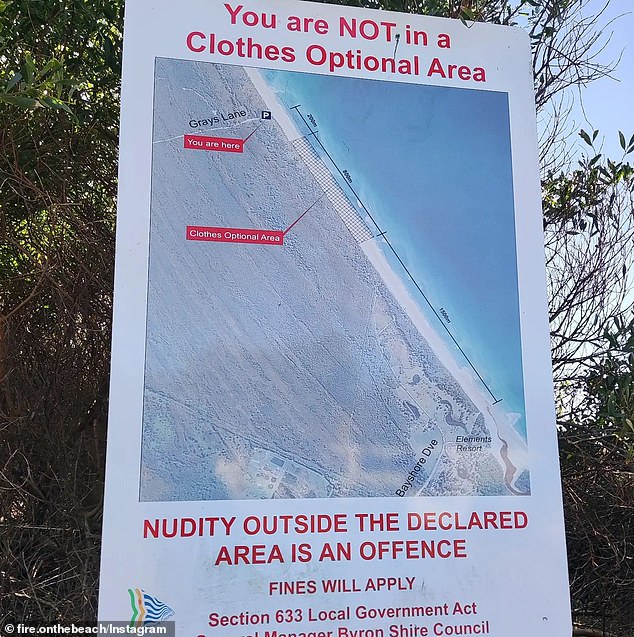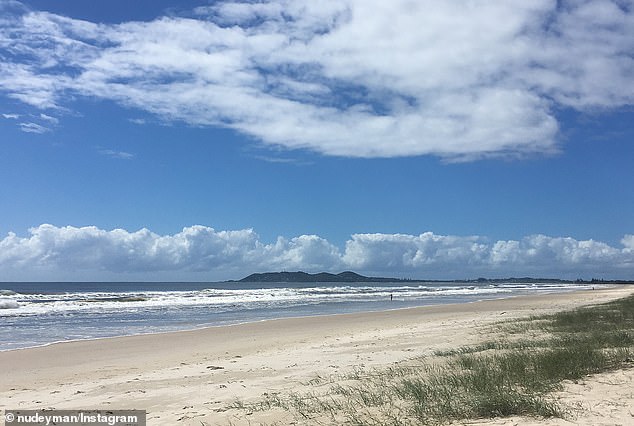Naturists may only have a few weeks left to strip off on a popular beach that one councilor once called “a swinger’s and dogger’s paradise.”
The New South Wales Parks and Wildlife Service (NWPS) has given notice that it intends to end the “clothing optional” provision for Tyagarah Beach, near Byron Bay, at the end north coast of New South Wales.
In a letter to Byron Bay Shire Council late last year, the NWPS said the nude beach was “not consistent with the values under which the reserve is managed”.
The wildlife service also requested that all signs and other official channels remove the notice that the beach is “clothing optional” to be removed by April 8.
Tyagarah Beach, located near the coastal town of Byron Bay in northern New South Wales, has been a “clothing optional” area since 1998.
The application will be voted on by councilors at a public meeting next Thursday.
The NPWS has confirmed to Council that the NPWS does not support having a clothing optional beach within Tyagarah Nature Reserve as it is inconsistent with the values of the reserve it manages,’ the council meeting agenda stated. Byron Shire Council.
In its letter, NWPS stated that naturists were moving away from the designated beach area to also use the dunes and back dunes, creating environmental problems.
A NPWS spokesperson told Nine News no final decision had been made.
He also promised to work with the community to look at other options.
“The New South Wales National Parks and Wildlife Service (NPWS) will continue to work with relevant stakeholders to identify alternative locations for the activity to take place,” the spokesperson said.
Bradley Benham of Byron Naturists has started a request to New South Wales Environment Minister Penny Sharpe, asking that the beach, which has been clothing optional since 1998, be kept open to nudists.
“Legal outdoor spaces for the naturist community are rare in NSW (and Australia) and this beach is highly valued by both committed and casual naturists in the Northern Rivers and SE Queensland,” the petition states.

A petition to keep Tyagarah Beach open for “future generations” of naturists is being prepared and will be sent to the NSW Environment Minister.
‘Nude recreation is a legitimate way of life, and the local community, interstate and international visitors have a right to some public space where this freedom can be expressed.
‘Tyagarah Beach, where nudist use is permitted, has been a place of fun and freedom since it was created by community activism more than 25 years ago. Thousands of people now enjoy this beach responsibly.
“Closing the beach at such short notice and without consulting the public or offering an alternative location is unfair.”
The petition also calls on the NPWS to reverse its decision for “future generations”.
By Tuesday afternoon it had garnered 785 signatures, very close to its goal of 1,000.
In 2018, the city council rejected a measure to close the beach because it was allegedly infested with sexual pests and public masturbation.
Instead, $10,000 worth of CCTV cameras were installed to appease worried locals.
Despite nudists’ concerns about their privacy, the council said it was a necessary step to “clean up the beach”.
Councilor Paul Spooner, who has long opposed the naturist provision, had previously warned he would hit any “sex pests” with a cricket bat if the nude beach remained open.
Spooner brought out a bat in the middle of the council meeting and said the beach had become a “paradise for swingers and dogs.”

The New South Wales Parks and Wildlife Service has stated that naturists do not stick to the area designated for them.
In September 2020, police were called to the beach following complaints about a party being held during Covid restrictions.
Officers responded to the scene and found more than 20 beachgoers present, more than the maximum number of attendees allowed for outdoor gatherings at the time.
Three revelers were fined $1,000 for failing to comply with COVID-19 public health orders.
The council had claimed jurisdiction over the beach, which it assumed was Crown land, until a study last year found the 800-metre stretch of sand was actually under the auspices of the NWPS.

